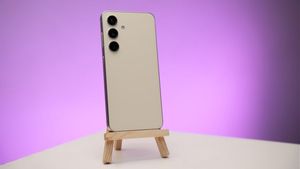JAKARTA - Japanese scientists have just taken the first steps to grafting live human skin onto robotic fingers. It really brings human-like robots one step closer.
The lab-grown lining is made up of real human skin cells and can heal itself when injured with the help of a collagen bandage.
And just like the original, the coating is water-resistant and creases when the robot's finger bends. But scientists doubt whether people will like its human-like anatomy or find it creepy.
"We were surprised by how well the skin tissue adapts to the robot's surface. But this work is only the first step towards creating a robot covered with living skin," said Shoji Takeuchi, a professor at the University of Tokyo who led the research.
The team argues that more lively robots could interact with people more naturally in a variety of roles, including in the care and service industries.
“I think live skin is the ultimate solution to give robots the look and touch of a living being because it's the exact same material that covers the animal's body. This (advancement) has the potential to build new relationships between humans and robots," said Takeuchi.
Previously, scientists had produced skin grafts, i.e. sheets of skin that could be stitched together in reconstructive surgery, but they were also struggling to create living skin on dynamic three-dimensional objects.
In this new work, the team first immersed a robotic finger into a cylinder filled with a solution of collagen and human dermal fibroblasts, the two main components that make up skin's connective tissue.
It coats the surface like a primer paint, providing a seamless layer for the next layer of human epidermal keratinocytes to adhere to.
Bending the finger back and forth can cause natural looking wrinkles to develop at the knuckles and when injured, the skin is made to heal like a human with the help of a collagen bandage and feels like normal skin.
Launching The Guardian, Friday, June 10, fingers are in progress, the skin is much weaker than natural skin and must be kept moisturized because without a circulatory system, the cells will die if they dry out. Movement is also very mechanical.
"Fingers look a little sweaty straight from the culture media. Since the fingers are driven by an electric motor, it's also interesting to hear the click of the motor in sync with the real finger," said Takeuchi.
The team now plans to incorporate more sophisticated functional structures within the skin, such as sensory neurons, hair follicles, nails, and sweat glands. They are also working on a robotic face covered in skin. The research was published in the journal Matter.
The English, Chinese, Japanese, Arabic, and French versions are automatically generated by the AI. So there may still be inaccuracies in translating, please always see Indonesian as our main language. (system supported by DigitalSiber.id)













